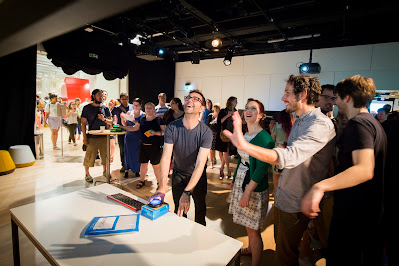One of the great joys of my work - which spans educational games, alternative controllers, and playable stage shows - is I’m constantly coming across new ways audiences will approach a piece of technology. The more I explore the more I find myself revisiting the same the same key design questions. In particular, how does my work create a space where users are ready to interact with it?
Put yourself in the mind of your user. What’s the first question you need to answer? The most obvious answer is what do I do?
But think again. What do I do presupposes that the user already knows that there is something to be done. Perhaps the user doesn’t even know that there’s something that can be interacted with. Even if they did, they may not even know why they'd want to interact with it at all.
Designing for interactions is not just about conveying information. It's about constructing meaning, providing context, and provoking emotions.
How does the user believe the interactive space already works?
What does the user want out of interacting?
What is the user afraid of?
 |
| Codex Bash at the Wellcome Collection, 2015 |
To give an example, in Codex Bash - a game built for exhibitions and museums - most users don’t know the game is there until they start playing it by accident.
In a video game exhibition, pressing a big colourful button is usually encouraged. So each of my big colourful buttons triggers the start of the game, ready to be pressed by an unwitting passer-by. With one press the game springs to life with colour and sound, displaying a puzzle so trivial it would be impolite not to complete it.
Once this has been solved, the player is an active headspace, willing to participate. Buoyed by success in a simple first puzzle they're emotionally prepared for the more complex challenges the game begins to throw at them.
 |
| The Book Ritual at GDC San Francisco, 2019 |
In The Book Ritual - a game where I invite players to shred a physical book - players are often afraid to deface a book. Defacing books is quite the taboo, especially in public.
So how can I assuage this fear? I sit the game among the mess and clutter left behind by the others who have come and shredded books before you. It's less intimidating to shred a book knowing that you will not be the first person to do it.
Interaction Design in Artholomew Video’s Reading Challenge
In this article I will take one of my interactive Twitch streams, and pick apart the user experience (UX) decisions that went into making a great show for viewers. Even in an environment where the only interaction the players have is to type into Twitch’s chat feature, there’s a surprising amount to be understood to allow for great interactivity.
Let’s have a look at one of my signature livestream games. This is the Reading Challenge segment from Artholomew Video’s Stream Challenge. Artholomew Video is a livestream video game collection I designed to get streamers and their viewers being creative together. It won the grand prize at the Creative Gaming Awards in Hamburg in 2022.







